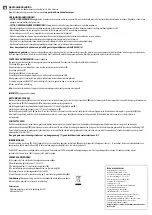
Grounding the Plumbing
It is important that the plumbing system be electrically
grounded. When a water softener is installed, a nonmetallic
bypass valve may interrupt the grounding. To maintain
continuity, a grounding strap can be purchased at a hardware
store. When it is installed, the strap will connect the plumbing
into the softener to the plumbing out of the softener.
If you have other water treating equipment such as; chlorinator,
sediment filter, neutralizer, iron filter, or taste & odor filter,
they should be installed upstream of the water softener.
You may wish to consult a water professional if additional water
treating equipment is to be installed.
Valve Layout
Outlet
Inlet
Meter
Cable
Drain
1/2" Tube
To Brine Tank
3/8" NPT
3/8" Tube
Figure 7
Drain Line Flow Control
The drain line flow control (DLFC) requires assembly
(Figure 8).
1. Locate parts and a roll of plumber's tape. The plumbing
adapters should be removed (Figure 10 Connector
Assembly).
2. Wrap the tape over threads of the flow control.
3. Screw the flow control and the 90° elbow together. Hand
tighten.
4. Place the ball into the flow control and insert the assembly
into the drain line opening.
5. Push the assembly in and secure with the drain line clip.
90° Elbow Flow Control
Control Ball
Drain Line Clip
Figure 8
Water Line Connection
Once you have selected your location, check the direction of the
water flow in the main pipe.
Inspect the main water pipe. Write down the type of pipe
(copper, plastic, galvanized etc.). Record the size of the pipe.
Plastic style pipes usually have the size printed on the outside.
Other pipes can be measured for the outside diameter and
converted into the pipe size at the store. Do not use pipe that is
smaller than the main water pipe.
If the main plumbing is galvanized pipe and you are installing
copper pipe, then you must use dielectric insulating connectors
between the two styles of pipe.
WARNING:
If pipes will be sweat soldered, do not connect
adapters to the bypass until the pipes have
cooled.
IN
OUT
IN
OUT
Connector
Assembly
“H” Clip
Drain
Line
Handles in Service
Handles in Bypass
Figure 9 Bypass Operation
IMPORTANT: When the valve is in bypass, water will not
enter the softening tank. The water in the building will not be
treated. Figure 9 Bypass Operation, shows the handles in the
service position.
WARNING:
The inlet water must be connected to the inlet
port of the valve. When replacing a water valve,
it is possible that the inlet and outlet plumbing
is installed in a reversed position. Be certain
the inlet connection on the valve is connected
to the incoming water fitting from the water
supply. Do not solder pipes with lead-based
solder.
WARNING:
Do not use petroleum grease on gaskets when
connecting bypass plumbing. Use only 100%
silicone grease products when installing any
plastic valve. Non-silicone grease may cause
plastic components to fail over time.
The bypass assembly connects to the water system by means
of a connector assembly. The connector is secured to the
plumbing and then inserted into the bypass. A clip is used to
hold it in place.
Figure 10 Connector Assembly
EQUIPMENT INSTALLATION
continued
6 •
AUTOTROL
368 Service Manual






































